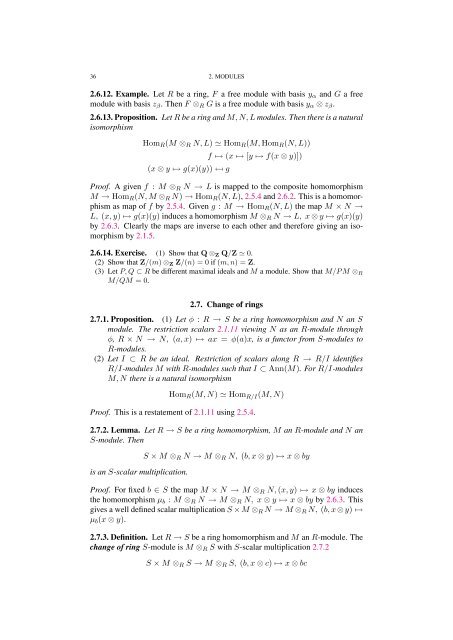Commutative algebra - Department of Mathematical Sciences - old ...
Commutative algebra - Department of Mathematical Sciences - old ...
Commutative algebra - Department of Mathematical Sciences - old ...
You also want an ePaper? Increase the reach of your titles
YUMPU automatically turns print PDFs into web optimized ePapers that Google loves.
36 2. MODULES<br />
2.6.12. Example. Let R be a ring, F a free module with basis yα and G a free<br />
module with basis zβ. Then F ⊗R G is a free module with basis yα ⊗ zβ.<br />
2.6.13. Proposition. Let R be a ring and M, N, L modules. Then there is a natural<br />
isomorphism<br />
HomR(M ⊗R N, L) HomR(M, HomR(N, L))<br />
(x ⊗ y ↦→ g(x)(y)) ← g<br />
f ↦→ (x ↦→ [y ↦→ f(x ⊗ y)])<br />
Pro<strong>of</strong>. A given f : M ⊗R N → L is mapped to the composite homomorphism<br />
M → HomR(N, M ⊗R N) → HomR(N, L), 2.5.4 and 2.6.2. This is a homomorphism<br />
as map <strong>of</strong> f by 2.5.4. Given g : M → HomR(N, L) the map M × N →<br />
L, (x, y) ↦→ g(x)(y) induces a homomorphism M ⊗R N → L, x ⊗ y ↦→ g(x)(y)<br />
by 2.6.3. Clearly the maps are inverse to each other and therefore giving an isomorphism<br />
by 2.1.5.<br />
2.6.14. Exercise. (1) Show that Q ⊗Z Q/Z 0.<br />
(2) Show that Z/(m) ⊗Z Z/(n) = 0 if (m, n) = Z.<br />
(3) Let P, Q ⊂ R be different maximal ideals and M a module. Show that M/P M ⊗R<br />
M/QM = 0.<br />
2.7. Change <strong>of</strong> rings<br />
2.7.1. Proposition. (1) Let φ : R → S be a ring homomorphism and N an S<br />
module. The restriction scalars 2.1.11 viewing N as an R-module through<br />
φ, R × N → N, (a, x) ↦→ ax = φ(a)x, is a functor from S-modules to<br />
R-modules.<br />
(2) Let I ⊂ R be an ideal. Restriction <strong>of</strong> scalars along R → R/I identifies<br />
R/I-modules M with R-modules such that I ⊂ Ann(M). For R/I-modules<br />
M, N there is a natural isomorphism<br />
HomR(M, N) Hom R/I(M, N)<br />
Pro<strong>of</strong>. This is a restatement <strong>of</strong> 2.1.11 using 2.5.4.<br />
2.7.2. Lemma. Let R → S be a ring homomorphism, M an R-module and N an<br />
S-module. Then<br />
is an S-scalar multiplication.<br />
S × M ⊗R N → M ⊗R N, (b, x ⊗ y) ↦→ x ⊗ by<br />
Pro<strong>of</strong>. For fixed b ∈ S the map M × N → M ⊗R N, (x, y) ↦→ x ⊗ by induces<br />
the homomorphism µb : M ⊗R N → M ⊗R N, x ⊗ y ↦→ x ⊗ by by 2.6.3. This<br />
gives a well defined scalar multiplication S × M ⊗R N → M ⊗R N, (b, x ⊗ y) ↦→<br />
µb(x ⊗ y).<br />
2.7.3. Definition. Let R → S be a ring homomorphism and M an R-module. The<br />
change <strong>of</strong> ring S-module is M ⊗R S with S-scalar multiplication 2.7.2<br />
S × M ⊗R S → M ⊗R S, (b, x ⊗ c) ↦→ x ⊗ bc
















